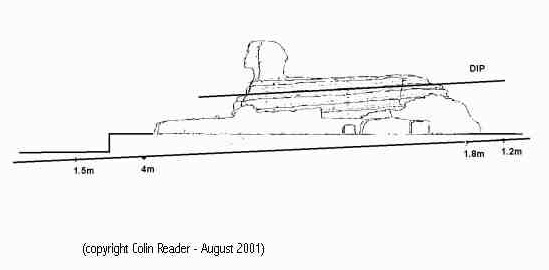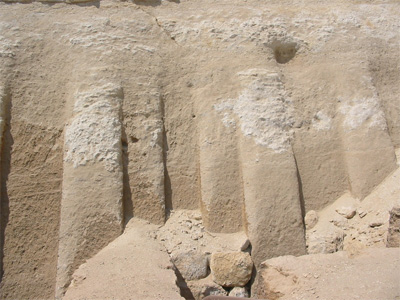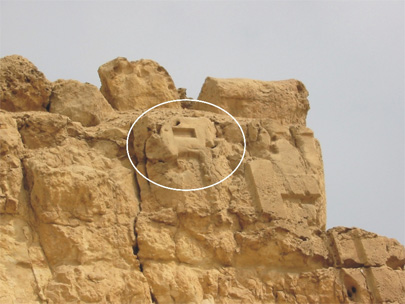For the alternative side, John Anthony West and Robert Schoch were to be joined by Graham Hancock, author of several books arguing that a maritime global culture existed late in the last Ice Age, and Robert Bauval, co-author of two books arguing that the layout of the three Giza Pyramids and the offset of the third reflected the belt stars in the constellation Orion. Bauval also argued that the relation of the three pyramids on the west bank of the Nile River reflected the position in the sky of Orion in relation to the Milky Way galaxy twelve thousand years ago.
Defending the traditional date for Giza were to be Ed Krupp, director of the Griffith Observatory in Los Angeles and author of several books on archaeoastronomy; Garrett Fagan, assistant professor of classics at Pennsylvania State University; Clair Ossian, professor of geology at Tarrant County College; and Donald Redford, Egyptologist and professor of classics at Pennsylvania State University.
The gathering would have been the first to bring together principals on the alternative side in a debate with academic scholars critical of their work. Unfortunately, the events of September 11, 2001, forced cancellation of the conference, which was not rescheduled.
The Debate Continues
Since 2001, several new articles and books have examined aspects of the Sphinx controversy, including some new questions.Colin D. Reader, "Giza Before the Fourth Dynasty," Journal of the Ancient Chronology Forum, Vol. 9 (2002), pp. 5-21.
Following Schoch's call for him to comment on the subsurface results, Reader included an examination of them in his 2002 JACF paper. Reader noted that in his 1992 KMT article, Schoch did not report the 3-4 meter depth of his S4 line in front of the Sphinx nor mention a sounding line (S9) that he had taken across the floor of the Sphinx Temple. Schoch did report these in his 1992 Geoarchaeology article.
The S9 line showed a slower-velocity region only 1.2-1.5 meters deep, which Schoch explained by pointing out that the Sphinx Temple probably protected the rock underneath from weathering. But since the floor of the temple was two and one-half meters lower than the floor of the enclosure behind it, Reader argued, the S9 depth together with the depths of the S3 and S4 lines could also be interpreted as evidence of a natural bedding layer (Fig.8.1 below): To strengthen his case that Giza was the site of building activity in the Early Dynastic period, Reader also noted the characteristic pattern of niching on Early Dynastic buildings. He observed that the tomb of Kai (Fig. 8.2 below) and the tomb of Khentkawes at Giza (Fig. 8.3 below), both identified with the Fourth Dynasty, also display this pattern of niching, unlike the other tombs at Giza. Robert M. Schoch, Voices of the Rocks, with Robert Aquinas McNally (New York: Harmony Books, 1999).
Robert M. Schoch, "Geological Evidence Pertaining to the Age of the Great Sphinx", in Emilio Spedicato and Adalberto Notarpietro, eds, New Scenarios on the Evolution of the Solar System and Consequences on History of Earth and Man, Proceedings of the Conference, Milano and Bergamo, June 7-9th, 1999, Universitą degli Studi di Bergamo, Quaderni del Dipartmento di Matematica, Statistica, Informatica ed Applicazion, Serie Miscellanea, Anno 2002, N. 3, pp. 171-203.
Robert M. Schoch, Voyages of the Pyramid Builders, with Robert Aquinas McNally (New York: Tarcher/Putnam, 2003), pp. 278-298.
Schoch restated his views on the Sphinx in his 1999 book and in a conference paper, and in an appendix to his 2003 book he responded to the criticisms by Harrell and Reader of his subsurface findings.
Schoch noted that the dip of the Giza plateau proceeds in a north-to-south as well as west-to-east direction. If the subsurface region that he interpreted to be weathered rock was only a natural layer in the rock, the soundings along his S2 line on the south flank of the Sphinx should have been deeper than his soundings along the S1 line on the north flank of the monument. In fact, the soundings along both lines were nearly the same depth (Fig. 8.4 below). Schoch concluded that the lower-velocity region was not a bedding difference. Mark Lehner, "The Sphinx," in Zahi Hawass (ed), The Treasures of the Pyramids (Vercelli, Italy: Barnes and Noble/White Star, 2003), pp. 173-189. Sidebar on pp. 176-177.
Mark Lehner, "Why Sequencing Is Important," in AERA: Ancient Egypt Research Associates.
In a chapter on the Sphinx contributed to the above book, Lehner returned to the Sphinx controversy in a sidebar on the Sphinx and Khafra Valley Temples. He restated the substance of the sidebar in a page on his website.
The remains of a low bench-like enclosure wall stand south of the south side of the Khafra Valley Temple (Fig. 8.5 below). The Tour Egypt site illustrates the wall in several photographs, the first showing the overall layout of the enclosure wall and the third (scroll down) showing the wall in diagram.
At its southwest corner, the wall turns north and almost touches the southwest corner of the Valley Temple. The wall proceeds east a short distance in front of the temple. The wall then turns north and stops short of the stone platform in front (east) of the temple. Lehner proposed that this wall continued to form a northeast corner, and he argued that an original northern enclosure wall proceeding west from this corner was dismantled or incorporated into the south wall of the Sphinx Temple.
Lehner concluded that the Khafra temple was built first, followed by its enclosure wall. A decision to build the Sphinx Temple then required the north side of the Khafra enclosure wall to be removed or incorporated into the south wall of the Sphinx Temple. The sequence dated the Sphinx Temple (and thus the Sphinx) to Khafra. Gerd Vandecruys, "The Sphinx: Dramatising data...and dating," PalArch: Netherlands Scientific Journal, Vol. 1, No. 1 (2006), 13 pp.
In an online exchange with Colin Reader in a new electronic journal PalArch, the Belgian observer Gerd Vandecruys revived Harrell's argument that rainwater would have drained into the sand and rubble of the quarries and then moved laterally (below the surface) into the Sphinx enclosure through the western walls.
To illustrate, Vandecruys cited Campbell's Tomb (Fig. 8.6 below), a shaft tomb located thirty meters west of the Sphinx enclosure. The tomb is at the bottom of a fifty-foot shaft sunk into the quarry floor and has been dated to about 600 BCE.[1] Sand filled the shaft until its excavation in the 1830s. The shaft walls belong to the same rock that compose the western enclosure wall of the Sphinx and show incipient horizontal recessions and vertical fissuring. The erosion in Campbell's Tomb could be seen as a younger stage of the same weathering visible on the Sphinx and its walls. Vandecruys argued that the cause was subsurface water moving laterally through the rock, eroding the walls from the inside out.
Vandecruys also questioned whether Khufu had intended to spare the ground for the Khafra Causeway from excavation. It is not known how far south and west Khufu excavated the plateau north of the causeway for stone to build his pyramid. If the Khufu Pyramid was built with a ramp extending to the Central Field Quarry in the south, the ramp could have covered the western half of the ridge that later formed the causeway. Khufu could have excavated only a part of the remaining area north of the causeway and it may have been Khafra who carried the northern excavation as far as the causeway itself.
Vandecruys noted that the northern terrace wall opposite the Sphinx Temple continues east of the temple into open space (Fig. 8.7 below). The wall east of the temple is more eroded than the section in the passageway opposite the north temple wall. Instead of having been cut at a later time, Vandecruys proposed that the better condition of the section in the passageway was the result of its more protected position. Colin Reader, "Response to Vandecruys (2006)," PalArch: Netherlands Scientific Journal, Vol. 1, No. 2 (2006), 13 pp.
In his response to Vandecruys, Reader observed that the water table at Giza is well below the floor of the Sphinx enclosure (and of Campbell's Tomb) and has been below it in historic times. Rainwater normally drains down to the water table. Some water might still have moved toward the enclosure along the relatively less permeable beds of Member II strata in the plateau behind the Sphinx. But the dip of the plateau would have caused any subsurface flow of water to erode the western enclosure wall more than the southern wall. Yet the western half of the southern wall shows as much erosion as the western wall.
Regarding Campbell's Tomb, Reader observed that its walls did not show any coving or rounding of the kind visible in the Sphinx enclosure. Reader also noted the erosion channel on the floor of the latter, originating below the major fissure on the southern wall, as evidence of surface runoff into the enclosure (drawn in Fig. 2.2).
Reader agreed that the northern terrace wall opposite the Sphinx Temple becomes slightly more weathered as it proceeds into open space to the east. But this difference does not explain the much greater contrast of these two exposures to the severely degraded wall opposite the north flank of the Sphinx.
Reader agreed that it was uncertain how much stone Khufu removed from the quarry north of the Khafra Causeway, and thus how far Khufu may have respected a preexisting pathway there. Reader observed that the likelihood of the ground for the causeway surviving Khufu's excavations by accident was still rather low. Gerd Vandecruys, "Response to Reader (2006): More geological and archaeological data on the Sphinx discussion," PalArch: Netherlands Scientific Journal, Vol. 1, No. 1 (2006), 11 pp.
In a follow-up article, Vandecruys argued that the plateau behind the Sphinx enclosure was criss-crossed with joints through which subsurface interflow could have reached the Sphinx enclosure more easily than through the rock itself. He noted that the top ledge of the southern enclosure wall was relatively smooth and uneroded compared to the deeply eroded strata of the wall below. Subsurface flow could better explain this anomaly than runoff, which should have eroded the top of the wall.
Vandecruys noted that the erosion channel on the floor of the Sphinx enclosure is incised in an area that still belongs to the Member II layer and thus probably required very little water to erode into its present form. Vandecruys also cited Lehner's argument that a low enclosure wall around the south side of the Khafra Valley Temple pointed to the construction of that temple before the Sphinx Temple. Colin Reader, "Further considerations on development at Giza before the 4th dynasty," PalArch: Netherlands Scientific Journal, Vol. 1, No. 2 (2006), 13 pp.
In his follow-up response, Reader noted that the force of any subsurface water that did flow laterally would have been greater moving downhill than uphill. Since interflow would have needed to go around the southwest corner of the Sphinx enclosure and then partly uphill to erode the southern wall from the inside out, the western end of the south wall should display less erosion than the western wall. But the western half of the southern wall is just as eroded as the western wall.
Regarding the uneroded top ledge of the southern wall, Reader proposed that the surface was recut to lay the Khafra Causeway and thus cannot be cited as evidence against surface runoff in earlier centuries. Traces that Reader interpreted as gulleying can still be seen at the base of the causeway. Reader proposed that the ground of the future causeway was only a path in Early Dynastic times.
Reader also pointed to a small section cut out of the degraded northern terrace wall inside the Sphinx enclosure (Fig. 8.8 below, marked A), below the New Kingdom temple. The rectilinearity and smoothness of the cutback resembled that of the wall opposite the north side of the Sphinx Temple but was more exposed than the latter. Reader argued that both should be dated to the Old Kingdom. In addressing the question of whether the Sphinx Temple rests on the northern perimeter of an enclosure wall originally planned or built as part of the Khafra Valley Temple, Reader asked if the stone identified as the northeast corner was in fact the corner of an enclosure wall. The stones are uneven and their continuity may be questioned. Since they appear to intercept the present southeast corner of the Sphinx Temple, which Herbert Ricke identified with the second stage of the temple's construction, they would not necessarily refute the case for an earlier Sphinx Temple.
1. Campbell's Tomb has been cited by others as an example of possible wet sand weathering. Vandecruys argued instead that the shaft walls eroded from the inside out.

Fig. 8.1. Reader drew a line connecting the depths of Schoch's lower-velocity soundings under the Sphinx and the Sphinx Temple. The line appears to be close to the natural west-to-east dip of the rock. Courtesy and copyright of Colin Reader.

Fig. 8.2. The vertical niches on the tomb of Kai. Courtesy and copyright of Colin Reader.

Fig. 8.3. The niches on the tomb of Khentkawes. Courtesy and copyright of Colin Reader.


Fig. 8.4. Schoch argued that his S1 and S2 lines were too similar in depth to be consistent with the north-south dip of the plateau.

Fig. 8.5. The Khafra Valley Temple showing enclosure wall (in olive green) along its south side. Inferred northeast corner intercepts the southeast corner of the Sphinx Temple.

Fig. 8.6. Campbell's Tomb. The shaft walls show evidence of erosion. Courtesy and copyright of John Bodsworth

Fig. 8.7. View of the Sphinx Temple from its front looking west. To the right, the northern terrace wall inside the passageway opposite the temple's north wall is less weathered than the continuation of the same terrace wall outside and east of the passageway. Courtesy and copyright of John Bodsworth. Arrows added.

Fig. 8.8. The severely eroded northern terrace wall inside the Sphinx enclosure terminates abruptly (at the cut marked "A") just below the New Kingdom temple. Courtesy and copyright of Colin Reader.
Go to next page.
Go to last page.
Go to index page.
